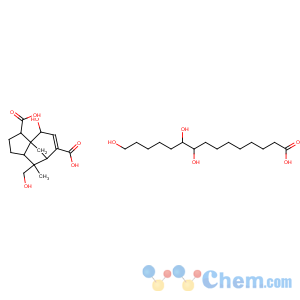Title: Shellac
CAS Registry Number: 9000-59-3
Synonyms: Lacca; lac
Literature References: A resinous excretion of the insect
Laccifer (Tachardia) lacca Kerr, order
Homoptera, family
Coccidae. Different resiniferous trees of India serve as host trees as the season progresses. The insects suck the juice of the tree and excrete "stick-lac" almost continuously. Whitest shellac is produced while the kusum tree
(Schleichera trijuga) is the host. Most shellac is produced in the Central and in the United provinces of India and in the states of Bihar and Orissa. The major component of lac is a resin which upon mild hydrolysis gives a complex mixture of aliphatic and alicyclic hydroxy acids and their polyesters. The composition of the hydrolysate depends on the lac source and the time of collection. The major component of the aliphatic fraction is aleuritic acid,
q.v.; the major component of the alicyclic fraction is shellolic acid,
q.v.: Yates, Field,
Tetrahedron 26, 3135 (1970). Physical and chemical properties of shellac: Cockeran, Levine,
J. Soc. Cosmet. Chem. 12, 316 (1961). Trends in shellac chemistry:
eidem, Am. Ink Maker 39 (7), 26 (1961); E. Hicks,
Shellac, Its Origin and Applications (Chemical Publ. Co., New York, 1961).
Review: J. Martin in
Kirk-Othmer Encyclopedia of Chemical Technology vol. 20 (Wiley-Interscience, New York, 3rd ed., 1982) pp 737-747.
Properties: Brittle, yellowish, transparent sheets or crushed pieces or powder. d 1.035-1.140. mp 115-120°. Sapon no. 185-210; iodine no. 10-18. Solubility in alcohol 85-95% w/w (very slowly sol); in ether 13-15%; in benzene 10-20%; in petr ether 2-6%. Sparingly sol in oil of turpentine. Insol in water; sol in aq solns of ethanolamines, of alkalies or borax with slightly purple color.
Melting point: mp 115-120°
Density: d 1.035-1.140
Use: Chiefly in lacquers and varnishes; also in manuf buttons, grinding wheels, sealing wax, cements, inks, phonograph records, paper; for stiffening hats; in electrical machines; coating confections and medicinal tablets; finishing leather.

